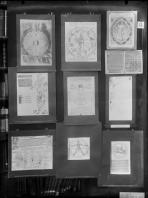Radial lines—Feet over the moon
In the opening statements of his lecture, Saxl argues that the belief in the correspondence between the human body and the world can be traced back to an Iranian myth of creation that refers to a “first man,” whose height equals his width and whose skin and bodily orifices represent the sky and other parts of the universe. While focusing on its Persian origins, Saxl emphasizes that similar versions of this “magical anatomy” can be found in several regions of the world, from the Chinese to the Maoris, who also attribute a number of “demonic” properties to specific body parts. Expanding on these “Asiatic origins” while reiterating an argument first made by Warburg, Saxl points out that Vitruvius’s reference to the equal dimensions of the human body was indebted to similar principles found in ancient Oriental texts and later “aestheticized” in Greek and Roman discourses.
Saxl considers the Christological visions of Hildegard von Bingen, such as the illustration of the microcosm and macrocosm depicted in #1, as one of the first signs of the “re-appearance” of pagan cosmologies in the Middle Ages. The reappearance of anthropomorphic concepts of the universe in a number of 12th-century illuminated manuscripts, such as the one by Hildegard, allow Saxl to argue that Medieval writers were familiar with ancient, hermetic, cosmogonic traditions (Saxl, vol. 1, p. 62). Hildegard represents man in the center of the heavenly sphere, outstretched arms and feet touching a circle and notes: “For the height of the human figure is equal to its width if arms and hands are evenly stretched out from the chest. This is because the firmament, too, is as long as it is wide.” Saxl notes that the figure is surrounded by winds with his feet connected with images of the seven planets via the means of “rays” and that God lies outside the “composition, holding in His arms the universe, of which the microcosm is in the center.”
